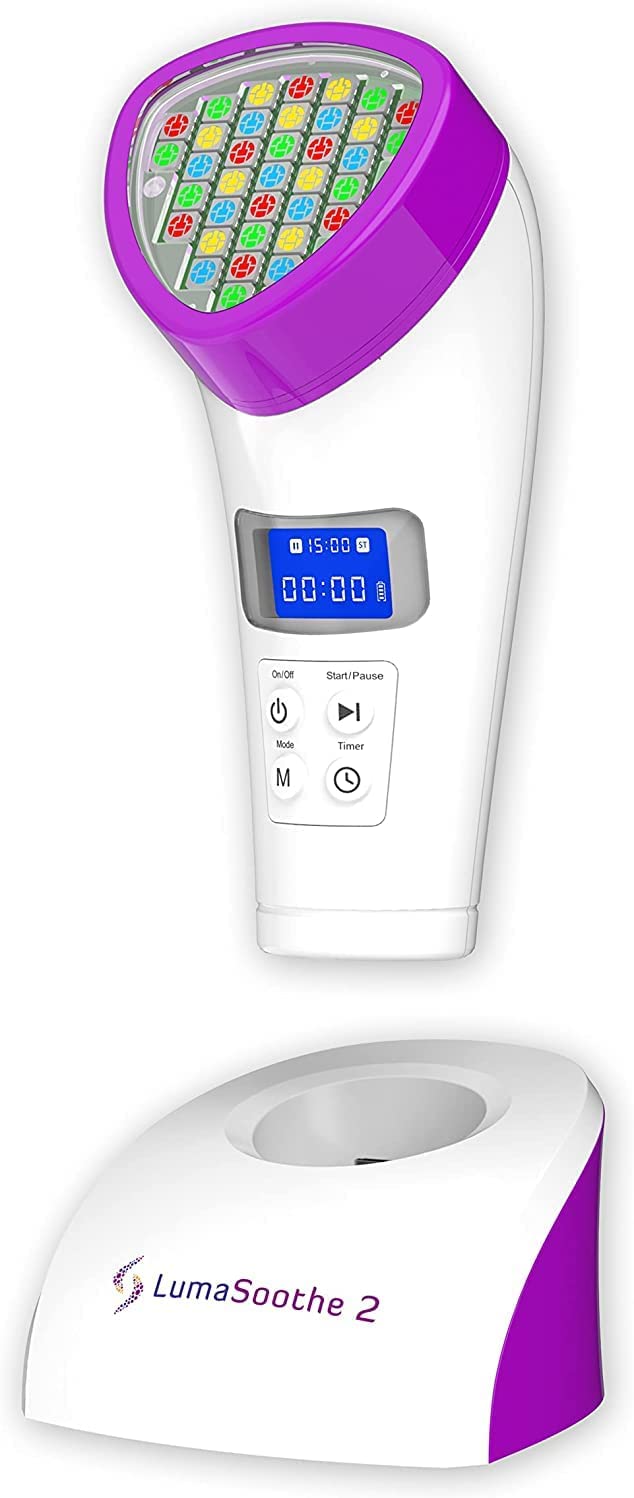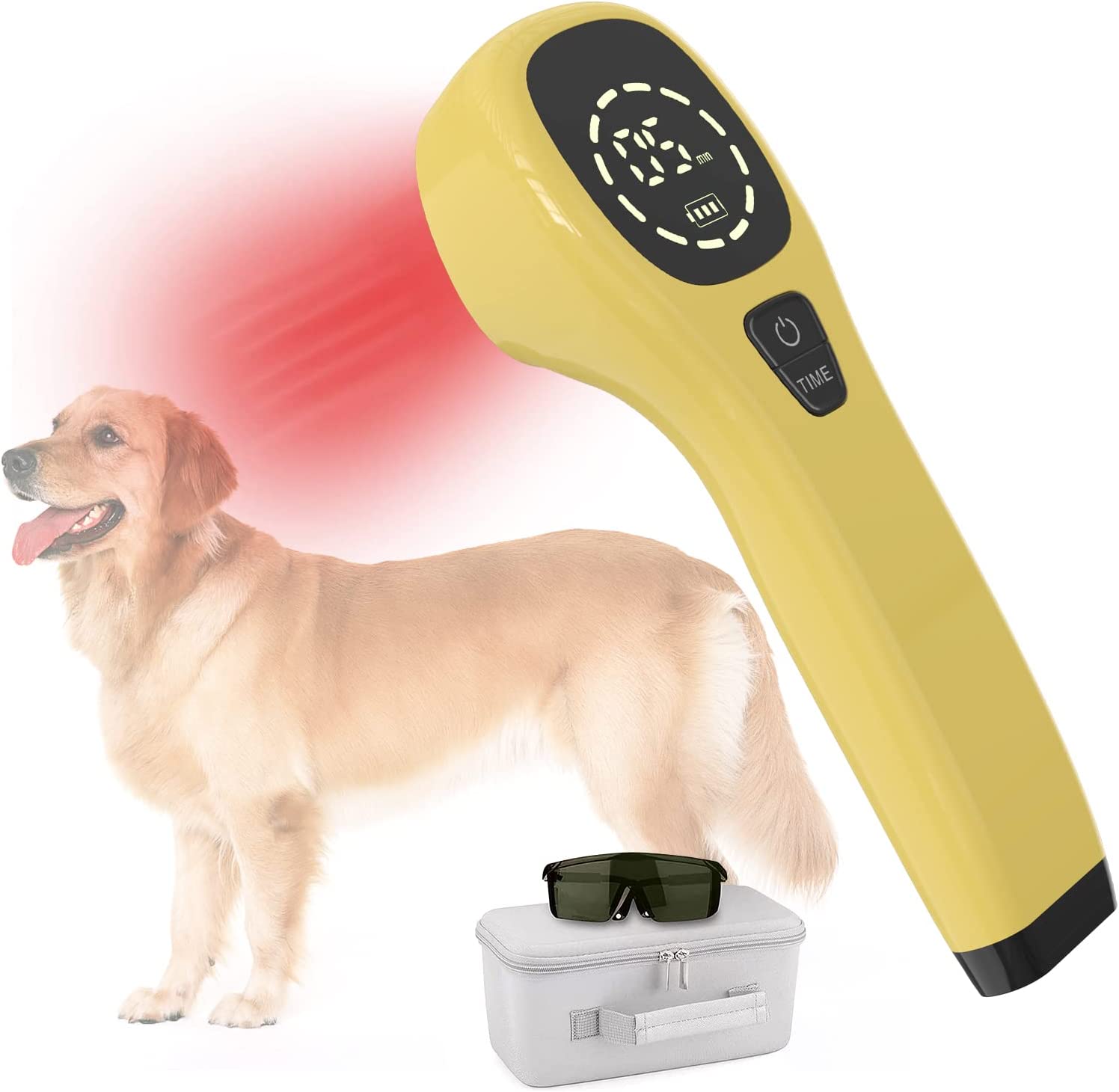iHeartDogs is reader-supported. When you buy via links on our site, we may earn an affiliate commission at no extra cost to you.
Red light therapy for dogs, also known as photobiomodulation therapy or low-level laser therapy, is a non-invasive treatment that uses red or near-infrared light to promote healing and reduce pain and inflammation in dogs. It involves the application of specific wavelengths of light to targeted areas of your dog’s body, such as joints, muscles, or wounds.
Red light therapy for dogs works by stimulating cellular activity and promoting circulation in the treated area. The red or near-infrared light penetrates the skin and is absorbed by the cells, where it interacts with the mitochondria, the energy-producing powerhouses of the cells. This interaction triggers various biochemical reactions that can have therapeutic effects on your dog’s body.

While red light therapy used to be available only at the veterinarian’s office, you can now find red light therapy devices for home use. And to help you find the safest and most effective options, we’ve compiled a list of the best red light therapy for dogs to narrow your search.
Before choosing a system, though, check out our buyer’s guide to learn what factors to consider when shopping and peruse the answers to the most asked questions about red light therapy for dogs.
Buyers’ Guide: Factors to Consider When Choosing the Best Red Light Therapy Systems for Dogs
When buying a red light therapy system for dogs, there are several factors to consider to ensure you choose a reliable and effective device. Keep these important factors in mind:
Wavelength and Power Density
The red light therapy system should emit the appropriate wavelengths of light for effective treatment. The ideal wavelengths for red light therapy in dogs are typically within the range of 630 to 850 nanometers (nm). Additionally, consider the power density or irradiance of the device, which indicates the amount of light energy delivered per unit area. Choosing a system with adequate power density is essential to ensure proper penetration and therapeutic effect.
Treatment Area and Coverage
Determine the size of the treatment area the device can cover. You may need a system with a broader treatment area or multiple light panels if you plan to treat larger areas or multiple body parts simultaneously. Consider the size and shape of the device and whether it can be easily maneuvered to target specific areas on your dog’s body.
Safety Features
Ensure the red light therapy system has appropriate safety features. Look for devices with built-in timers to control treatment duration and prevent overexposure.
Ease of Use
Consider the user-friendliness of the device. Look for systems that are easy to operate, with clear instructions and intuitive controls. Portable and lightweight devices may also be more convenient for home use or treating dogs in different locations.
Quality and Durability
It’s important to choose a red light therapy system from a reputable manufacturer known for producing high-quality devices. Read product reviews and check for certifications or compliance with relevant safety and quality standards. Ensure the device is durable and able to withstand regular use.
Cost
Consider your budget and the overall value provided by the red light therapy system. While investing in a quality device is essential, it’s also important to find one that fits within your financial means.
Before purchasing a red light therapy system, it’s advisable to consult with a veterinarian or a veterinary professional experienced in photobiomodulation therapy. They can provide guidance and recommend specific devices based on your dog’s needs and condition.
The 4 Best Red Light Therapy for Dogs
1 – LumaSoothe 2 Light Therapy for Dogs
LumaSoothe 2 Light Therapy for Dogs utilizes the power of light therapy to provide soothing relief with a user-friendly compact design. The adjustable settings allow for customized treatment based on your dog’s specific needs. The red and infrared lights work together to promote healing, reduce inflammation, and alleviate pain while penetrating to a depth of about 30 – 40mm. The results are impressive, with many pet parents reporting significant improvements in their dog’s mobility and overall well-being.
Pros
- Adjustable settings for various treatments
- Rechargeable via USB cord
- Compact and user-friendly design
- Convenient at-home light therapy for dogs
Cons
- Doesn’t work for every dog
2 – LifePro Red Light Therapy Device Wand
The LifePro Red Light Therapy Device Wand is a versatile and effective tool that’s incredibly user-friendly and easy to use. It features adjustable intensity levels and multiple treatment modes, allowing for personalized sessions tailored to individual needs. The wand’s versatility makes it suitable for targeting various areas of the body, such as the face, joints, and muscles.
Pros
- Lightweight & portable
- Comes with a pet care instruction sheet
- Rechargeable
- Well-rated on Amazon
Cons
- Tripod may not be that easy to use
3 – PUPCA Cold Laser Therapy Device for Dogs
The PUPCA Cold Laser Therapy Device for Dogs delivers effective pain relief and healing with a compact, portable pad design that’s easy to use and suitable for at-home treatment. Like other redlight therapy systems for dogs on our list, this option also allows you to adjust settings for customized treatment based on your dog’s specific needs. Unlike the other options, this therapy device offers red light healing via a strap-on pad instead of a handheld device. This makes treatment easier for both of you! It’s a safe and non-invasive way to provide a gentle, healing experience.
Pros
- Easy to use
- Safe and comfortable for dogs
- Adjustable elastic straps for good fit
- Automatic timer
- Rechargeable
Cons
- No instruction manual included
4 – KTS Cold Laser Therapy for Dogs
The KTS Cold Laser Therapy device employs low-level laser technology to address various conditions, including arthritis, muscle injuries, and post-surgical recovery. The device is lightweight and easy to use, making it suitable for home treatments. There are only a limited number of reviews on this option, but the majority of them are positive, with dog parents reporting easy use and good results from therapy.
Pros
- Rechargeable
- Long battery life
- Easy-to-hold design
- Simple to use
Cons
- Limited reviews
FAQs About Red Light Therapy Systems for Dogs
What are the benefits of red light therapy for dogs?
Red light therapy has been used in human medicine for many years and has shown positive results in promoting tissue repair, reducing pain and inflammation, and accelerating wound healing. Its application to veterinary medicine, including dogs, has gained popularity in recent years.
Some of the potential benefits of red light therapy for dogs include:
- Pain relief: Red light therapy can help alleviate pain associated with various conditions such as arthritis, joint inflammation, muscle strains, or injuries.
- Reduced inflammation: The therapy can help reduce inflammation in affected areas, which may contribute to improved mobility and decreased discomfort.
- Enhanced wound healing: Red light therapy can stimulate cellular regeneration and improve blood flow to wounds, aiding in healing and potentially reducing the risk of infection.
- Improved mobility: By reducing pain and inflammation, red light therapy may improve a dog’s mobility and joint function, particularly in older dogs or those with musculoskeletal issues.
- Accelerated post-surgery recovery: Red light therapy may help dogs recover faster after surgical procedures by promoting tissue healing and reducing swelling.
It’s important to note that a qualified veterinary professional should administer red light therapy unless you’ve already spoken with your vet about using red light therapy for dogs at home. The duration and frequency of therapy sessions can vary depending on the condition being treated and your dog’s specific needs.
Is red light therapy safe for dogs?
Red light therapy is generally considered safe for dogs when used correctly. It’s a non-invasive and non-thermal treatment that does not involve the use of medication or surgery. However, as with any treatment, there are important considerations to keep in mind:
- Proper device selection: Use a red light therapy device specifically designed for veterinary use or approved for use on animals. Human devices may have different specifications or wavelengths that may not be suitable for dogs.
- Correct settings and duration: Follow the manufacturer’s guidelines or consult a veterinarian to determine the appropriate settings and duration of red light therapy for your dog’s specific condition. Using excessive or prolonged exposure to red light may have adverse effects.
- Eye protection: Protect your dog’s eyes from direct exposure to red light. Dogs’ eyes are sensitive to light, and prolonged exposure to bright light can potentially cause damage. Ensure that your dog’s eyes are shielded during treatment.
- Avoiding sensitive areas: Red light therapy should be applied cautiously around sensitive areas such as the genitals, open wounds, or areas with cancerous growths.
- Individual sensitivity: Dogs, like humans, have varying individual sensitivities or reactions to treatments. It’s important to closely monitor your dog during and after red light therapy sessions to ensure they’re not experiencing any adverse reactions.
As always, it’s recommended to consult with a veterinarian before starting any new treatment, including red light therapy. The veterinarian can provide guidance on the proper use of red light therapy and monitor your dog’s progress throughout the treatment.
Related: 10 Best Eye Supplements for Dogs
Are there any side effects of red light therapy for dogs?
Red light therapy side effects, like skin irritation or photosensitivity, are relatively rare, and the majority of dogs tolerate red light therapy well. However, red light therapy may not be suitable for dogs with seizure disorders or cancerous growths. If you notice any concerning or persistent side effects, discontinue the treatment and consult a veterinarian for further evaluation and guidance.
Can red light therapy help with my dog’s joint pain or arthritis?
Red light therapy has shown potential for managing joint pain and arthritis in dogs. While it may not provide a cure, it can be used as a complementary therapy to help alleviate symptoms and improve quality of life by reducing inflammation, increasing blood circulation, enhancing tissue repair, and managing pain.
It’s important to note that the effectiveness of red light therapy for joint pain and arthritis may vary between individual dogs, and the degree of improvement can depend on factors such as the severity of the condition and your dog’s overall health.
Can red light therapy help with my dog’s skin conditions?
Yes, red light therapy has shown potential for improving various skin conditions in dogs, providing benefits such as:
- Wound healing: Red light therapy can help promote wound healing by stimulating cell growth and increasing blood circulation to the treated area. It may be beneficial for managing skin ulcers, surgical incisions, hot spots, and other types of wounds.
- Dermatitis and allergies: Red light therapy’s anti-inflammatory properties can help reduce redness, itching, and inflammation associated with dermatitis and allergies.
- Infections: Red light therapy has been found to have antimicrobial properties, potentially aiding in the management of certain skin infections. However, it’s important to note that red light therapy alone may not treat severe or deep infections.
- General skin health: Red light therapy may contribute to overall skin health by stimulating collagen production, improving skin elasticity, and enhancing the skin’s natural healing processes. It can help maintain a healthy skin barrier and potentially reduce the occurrence of certain skin issues.
It’s important to consult a veterinarian to properly diagnose your dog’s specific skin condition and determine if red light therapy is an appropriate treatment option.
How long does a red light therapy session for dogs typically last?
The duration of a red light therapy session for dogs can vary depending on the specific device being used and the condition being treated. However, a session typically lasts between 5 and 30 minutes on average. The exact duration may be influenced by factors such as the size of the treatment area, the power output of the device, and the specific treatment protocol recommended by your veterinarian or the device manufacturer. Additionally, some dogs may benefit from daily sessions, while others may require treatments every few days or once a week.
How soon can I expect to see results from red light therapy in my dog?
The timeframe for seeing results from red light therapy in dogs can vary depending on several factors, including the specific condition being treated, the severity of the condition, and individual response. In some cases, improvements may be noticed relatively quickly, while in others, it may take more time. Here are a few general considerations:
- Acute conditions: For certain acute conditions, such as minor wounds or skin irritations, you may observe noticeable improvements within a few days to a week of starting red light therapy. This can include reduced redness, swelling, and improved healing.
- Chronic conditions: Chronic conditions like arthritis or long-standing skin issues may require a longer treatment period before significant improvements are seen. It may take several weeks or even a few months of consistent therapy to observe noticeable changes. Keep in mind that individual responses can vary, and some dogs may show improvements sooner than others.
- Gradual improvements: In many cases, the benefits of red light therapy may be incremental and cumulative over time. You may notice a gradual decrease in symptoms, increased mobility, improved skin condition, or overall better well-being as treatment progresses.
It’s important to have realistic expectations and understand that red light therapy may not provide immediate or miraculous results. Each dog’s response to the therapy can differ, and some dogs may be more responsive than others. Consistency and adherence to the recommended treatment protocol, as advised by your veterinarian, are key to optimizing the potential benefits of red light therapy.
Final Thoughts
When considering the best red light therapy devices for dogs, it’s crucial to prioritize safety, efficacy, and ease of use. Ensure you choose red light systems specifically designed for dogs. And before beginning with red light therapy, always consult your veterinarian first.
Dog Product Reviews
- Best Dog Foods
- Best Fresh Dog Foods
- Best Freeze Dried Dog Foods
- Best Raw Dog Foods
- Best Online Dog Training Classes
- Best Fish Oil for Dogs
- Best Multivitamins for Dogs
- Best Invisible E-Fences for Dogs
- Best Grooming Tools for Dogs
- Best Beds for Senior Dogs
- Best Dog Toys
- Best GPS & Tracking Collars
- Best Dog Grooming Clippers
- Best No-Pull Dog Harnesses
- Best Pet Safe Weed Killers






 Toledo, United States.
Toledo, United States.